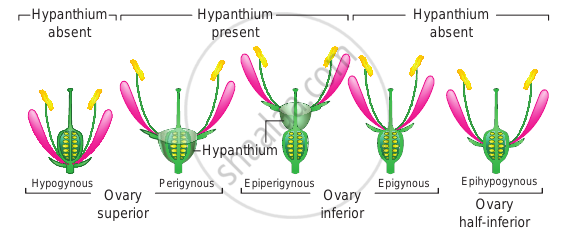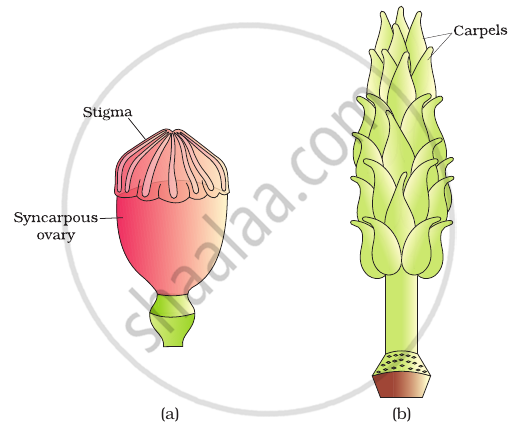Topics
Sexual Reproduction in Flowering Plants
- Flower - a Fascinating Organ of Angiosperms
- Parts of Flower
- Accessory Organs
- Essential Parts of Flower: Androecium
- Essential Parts of Flower: Gynoecium
- Sexual Reproduction in Flowering Plants
- Pre-fertilisation in Flowering Plant: Structures and Events
- Development of Anther
- Transverse Section of Mature Anther (Microsporangium)
- Microsporogenesis
- Microspores and Pollen Grains
- Development of Male Gametophyte
- Advantages and Disadvantages of Pollen Grains
- Structure of Ovule (Megasporangium)
- Types of Ovules
- Megasporogenesis
- Development of Female Gametophyte or Embryo Sac
- Pollination
- Outbreeding Devices
- Artificial Hybridization
- Kinds of Pollination
- Self Pollination (Autogamy)
- Cross Pollination
- Agents of Pollination
- Abiotic Agents
- Biotic Agents
- Fertilization Process
- Fertilization Process
- Post Fertilisation in Plant: Structures and Events
- Development of Endosperm
- Post Fertilization in Plant: Development of Embryo (Embryogeny)
- Development of Seed
- Development of Fruit
- Apomixis
- Polyembryony
Reproduction in Organisms
- Life Span of Organisms
- Maximum Life Span of Organisms
- Reproduction in Organisms
- Types of Reproduction
- Asexual Reproduction
- Sexual Reproduction in Animals
- Asexual Reproduction in Plant
- Asexual Reproduction in Animal
- Budding
- Vegetative Reproduction
- Natural Vegetative Reproduction
- Artificial Vegetative Reproduction
- Artificial Vegetative Reproduction
- Artificial Vegetative Reproduction
- Fission
- Budding
- Sporulation (Sporogenesis)
- Fragmentation
- Different Phases in Sexual Reproduction
- Sexual Reproduction in Animals
- Pre-fertilisation Events in Organisms
- Fertilisation in Organisms
- Post-fertilisation Events in Organisms
Reproduction
Genetics and Evolution
Human Reproduction
Reproductive Health
Biology and Human Welfare
Environmental Issues
- Environmental Issues
- Prevention of Air Pollution
- Controlling Vehicular Air Pollution: a Case Study of Delhi
- Introduction of Water Pollution and Its Control
- Effects of Domestic Sewage and Industrial Effluents on Water
- A Case Study of Integrated Waste Water Treatment
- Solid Wastes
- Agrochemicals and Their Effects
- Radioactive Wastes
- Greenhouse Effect and Climate Change
- Ozone Depletion in the Stratosphere
- Degradation by Improper Resource Utilisation and Maintenance
- Deforestation and Its Causes
- Radioactive Waste Management and E-waste
- Solid Waste Management
- Noise Pollution
- Environmental Issues
Biotechnology
Principles of Inheritance and Variation
- Introduction of Principles of Inheritance and Variation
- Mendelism
- Terminology Related to Mendelism
- Mendel’s experiments on pea plant
- Monohybrid Cross
- Gregor Johann Mendel – Father of Genetics
- Punnett Square
- Back Cross and Test Cross
- Mendelian Inheritance - Mendel’s Law of Heredity
- The Law of Dominance
- The Law of Segregation (Law of Purity of Gametes)
- The Law of Independent Assortment
- Intragenic Interactions - Incomplete Dominance
- Intragenic Interactions - Codominance
- Gregor Johann Mendel – Father of Genetics
- Extensions of Mendelian Genetics (Deviation from Mendelism)
- Intragenic Interactions - Incomplete Dominance
- Intragenic Interactions - Dominance
- Intragenic Interactions - Codominance
- Multiple Alleles
- Intragenic Interactions - Pleiotropy
- Polygenic Inheritance
- Chromosomal Theory of Inheritance
- Historical Development of Chromosome Theory
- Comparison Between Gene and Chromosome Behaviour
- Chromosomal Theory of Inheritance: Law of Segregation
- Chromosomal Theory of Inheritance: Law of Independent Assortment
- Linkage and Recombination
- Sex Determination
- Sex Determination in Some Insects
- Sex Determination in Human
- Sex Determination in Birds
- Sex Determination in Honey Bees
- Concept of Mutation
- Pedigree Analysis
- Genetic Disorders
- Mendelian Genetics
- Chromosomal Abnormalities
- Heredity and Variation
- Linkage and Crossing Over
- Principles of Inheritance and Variation Question
Molecular Basis of Inheritance
- Introduction of Molecular Basis of Inheritance
- Deoxyribonucleic Acid (DNA) and Its Structure
- Structure of Polynucleotide Chain
- Packaging of DNA Helix
- Search for Genetic Material
- Introduction of Search for Genetic Material
- The Genetic Material is a DNA
- Properties of Genetic Material (DNA Versus RNA)
- The RNA World
- DNA Replication
- The Experimental Proof
- The Machinery and the Enzymes
- Protein Synthesis
- Introduction of Transcription
- Transcription Unit
- Transcription Unit and the Gene
- Types of RNA and the Process of Transcription
- Genetic Code
- Genetic Code
- Genetic Code
- tRNA – the Adapter Molecule
- Translation
- Regulation of Gene Expression
- Operon Concept
- Human Genome Project
- DNA Fingerprinting Technique
- Structure of DNA and RNA
- Structure of Nucleotide
- Rice Genome Project
- Molecular Basis of Inheritance (Questions)
Ecology
Evolution
- Origin and Evolution of Universe and Earth
- Theories of Origin of Life
- Evolution of Life Forms - a Theory
- Evidences for Biological Evolution
- Theories of Biological Evolution
- Adaptive Radiation
- Organic Evolution
- Hardy Weinberg’s Principle
- Brief Account of Evolution
- Human Evolution
- Darwinism
- Micro and Macro Evolution
- Speciation
- Evolution Stages
- Modern Synthetic Theory of Evolution
- Gene Flow and Genetic Drift
- Evolution
Human Health and Diseases
- Introduction of Human Health and Diseases
- Common Diseases in Human Beings
- Immunity
- Types of Immunity
- Vaccination and Immunization
- Allergies (Hypersensitivity)
- Autoimmunity
- Human Immune System
- Sexually Transmitted Diseases (STD)
- Cancer
- Introduction of Drugs and Alcohol Abuse
- Drugs and Alcohol Abuse
- Adolescence - Drug and Alcohol Abuse
- Addiction and Dependence
- Effects of Drug and Alcohol
- Prevention and Control of Drugs and Alcohol Abuse
- Infectious and Non Infectious Disease
- Maintaining Good Health, Yoga, Excercise
- Human Health and Diseases (Questions)
Strategies for Enhancement in Food Production
Microbes in Human Welfare
- Microbes in Human Welfare
- Microbes in Household Products
- Microbes in Industrial Production
- Microbes in Sewage Treatment
- Microbes in Production of Biogas
- Microbes as Biocontrol Agents
- Microbes as Biofertilizers
- Energy Generation
- Production and Judicious Use
- Microbes in Human Welfare
Biotechnology - Principles and Processes
- Process and Principles of Biotechnology
- Restriction Enzymes
- Cloning Vectors
- Competent Host (For Transformation with Recombinant DNA)
- Processes of Recombinant DNA Technology
Biotechnology and Its Application
Organisms and Populations
- Introduction of Organisms and Populations
- Ecology (Organism, Population, Community and Biome)
- Introduction of Organisms and Environment
- Major Abiotic Factors
- Responses to Abiotic Factors
- Population Attributes
- Population Growth
- Life History Variation
- Population Interactions
- Population and Ecological Adaptations
- Organisms and Populations (Questions)
Ecosystem
- Ecosystem
- Introduction and Types of Ecosystem
- Ecosystem - Structure and Function
- Productivity
- Decomposition
- Concept of Energy Flow in an Ecosystem
- Ecological Pyramids
- Ecological Succession
- Nutrient Cycles
- Ecosystem Services
- Ecosystems Patterns
Biodiversity and Its Conservation
- Biodiversity
- Species on Earth and Species in India
- Patterns of Biodiversity
- Importance of Species Diversity to the Ecosystem
- Loss of Biodiversity
- Conservation of Biodiversity
- Endangered Organisms
- Importance of Biodiversity
- Extinction
- Red Data Book
- Biodiversity and Its Conservation (Questions)
- Gynoecium: Female Reproductive Organ
- Female Reproductive unit: Pistil
- Carpel
- Number of locules
- Extension of the condensed internode of the receptacle
- Ovary position
- Perianth / Androecial position on thalamus
Notes
Gynoecium: Female Reproductive Organ
- The gynoecium represents the female reproductive part of the flower.
- Gynoecium consists of carpels or pistils or megasporophylls.
- Gynoecium (carpel) arises as a small papillate outgrowth of meristematic tissue from the growing tip of the floral primordium. It grows actively and soon gets differentiated into ovary, style and stigma. The ovules or megasporangia arise from the placenta.
Notes
Female Reproductive unit: Pistil
- Each pistil has three parts, the stigma, style, and ovary.
- Stigma: The stigma serves as a landing platform for pollen grains.
- Style: The style is the elongated slender part beneath the stigma.
- Ovary: The basal bulged part of the pistil is the ovary. Inside the ovary is the ovarian cavity (locule). The placenta is located inside the ovarian cavity. Arising from the placenta are the megasporangia, commonly called ovules. The number of ovules can differ from one (e.g., wheat, rice, mango) to many (e.g., papaya, watermelon, orchids).
 Pistil |
Notes
Carpel:
- A pistil is derived from a carpel. They are components of a gynoecium.
- Gynoecium is made of one or more carpels.
- Carpels may be distinct or connate.
Number of carpel:
- Unicarpellary (monocarpellary) - Single carpel Example: Fabaceae
- Bicarpellary - Two carpels Example: Rubiaceae
- Tricarpellary - Three carpels Example: Cucurbitaceae
- Tetracarpellary - Four carpels Example: Lamiaceae.
- Multicarpellary - Many carpels Example: Nymphaeceae.
Fusion of carpels:
It is an important systematic character. Apocarpous gynoecium is generally thought to be ancestral condition in Angiosperms.
- Apocarpous - A pistil contains two or more distinct carpels. Example: Annona.
- Syncarpous - A pistil contains two or more carpels which are connate. Example: Citrus, tomato.
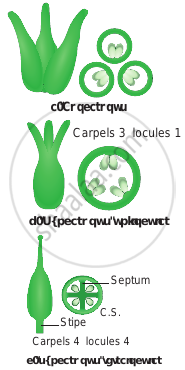
Fusion of carpels
Notes
Number of locules:
Ovarybears ovules on a specialized tissue called placenta. A septum is a crosswall or partition of ovary. The walls of ovary and septa form a cavity called locule. Like that tetralocular and pentalocular ovaries are present according to the locule numbers four or five. More than one locule ovaries are called plurilocular.
|
Locules |
Notes
Extension of the condensed internode of the receptacle:
- Anthophore: The internodal elongation between calyx and corolla. Example: caryophyllaceae (Silene conoidea).

Anthophore
- Androphore: The internodal elongation between the corolla and androecium. Example: Grewia.

Androphore
- Gynophore: The internodal elongation between androecium and gynoecium. Example: Capparis.
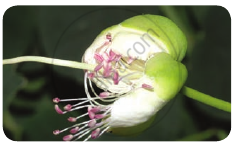
Gynophore
- Gynandrophore or Androgynophore: The unified internodal elongation between corolla and androecium and androecium and gynoecium. Example: Gynandropsis.
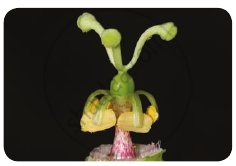
Androgynophore
Notes
Ovary position:
The position or attachment of ovary relative to the other floral parts. It may be classified into
- Superior ovary: It is the ovary with the sepals, petals, and stamens attached at the base of the ovary.
- Inferior ovary: It is the ovary with the sepals, petals, and stamens attached at the apex of the ovary.
- Half-inferior ovary: It is the ovary with the sepals, petals, and stamens or hypanthium attached near the middle of the ovary.
- Hypogynous: The term is used for sepals, petals, and stamens attached at the base of a superior ovary. Example: Malvaceae
- Epihypogynous: The term is used for sepals, petals, and stamens attached at the middle of the ovary (half-inferior). Example: Fabaceae, Rosaceae.
- Epigynous: The term is used for sepals, petals, and stamens attached at the tip of an inferior ovary. Example: Cucumber, Apple, Asteraceae.
- Perigynous: The term is used for a hypanthium attached at the base of a superior ovary.
- Epiperigynous: The term is used for hypanthodium attached at the apex of an inferior ovary.
Notes
Perianth / Androecial position on thalamus:
It describes the placement of the perianth and androecium relative to the ovary and to a hypanthium if present.
|
Perianth / Androecial position on thalamus |
Hypanthium (Staminal disk): a fleshy elevated often nectariferous cup-like thalamus.

